What Can I Use To Repair The Back Heel Of Shoes
I used to habiliment holes in the back of my shoes very quickly. While the remainder of the shoe was fine, 1 tends to throw them out and purchase new ones because they were merely so uncomfortable. When this happens, the shoe lining opens up and cream spews along. If you look closely, you'll see the hard plastic of the heel counter. This signals the unfortunate, and sometimes premature, demise of your shoes. ? Or does it? ?
Every bit it turns out, this is a very common event. In fact, I hear from people every week with this exact consequence. So let's wait closer at why it happens and how you can fix information technology. I accept to admit, this has happened to many of my walking, running and casual shoes. Thankfully, I've found a way to forbid information technology. The thing that fixed it for me was the thing I employ to forbid heel blisters – which I endure from far too easily. And then I've killed two birds with ane rock and I could not exist happier about that!
Who wears holes in the dorsum of their shoes?
All sorts of people (young/former, male/female person) during all sorts of activities (walking, hiking, running, ultrarunning, sports, activities of daily living) with all sorts of feet and biomechanics. Here are a few examples:
Hiking footwear
"What causes my heel to swallow the padding out of the back of my shoes? Shoes too large, or too brusk? Or am I buying shoes with oddly shaped heel cups? Any suggestions would exist dandy appreciated! Showtime pair were Inov8 Rocklite 295 size 10s. Loved the shoes merely ultimately had to become something with more support. I wore them for 60 miles hiking and a few curt runs. My heel wore through the textile on the heel cup and was working on the padding when I quit using them. Second pair were La Sportiva Bushidos size 42.5s (Usa ix.5). After wearing these for two months, including multiple day hikes, my heel had completely worn all the textile and padding out of the heel loving cup. Looking into the shoe yous would see the plastic frame of the heel loving cup through a pigsty the size of a quarter. In both shoes I could usually tape my heel to prevent blisters, but the shoes and socks nevertheless wear out."
Bakpacking Lite
Running shoes
"Why practice I vesture out the heels on the INSIDE of my shoes? It goes all the way to the core of the shoe where my heelbone (if that exists) touches the rear of my shoe. It basically rubs enough and wears to give me a blister. I cannot find a pair of shoes that I tin non wearout? Weird that the old Nike structure Triax viii didn't wear on me, but everything else does, Asics, Saucony, etc."
Let'south Run
"How can I forbid my shoes from ripping in the back (in the heel linings)? So after searching this subreddit I got a fantastic pair of New Balance'southward, they stone. The only thing I'yard worried nigh is what happened to my old pair of running shoes, the heel linings eventually got ruined, they kind of looked similar this at one indicate, it's non my actual pair but the tears are somewhat similar. All I would do is run with them on the treadmill. And then my question is, is there annihilation I can practice to forbid information technology from reoccurring with my new pairs?"
Reddit
Why does information technology happen?
I'm not aware of whatever research on this issue. However, I practise accept some pretty business firm thoughts on potential contributing factors.
Haglund'south
At that place is 1 bony deformity that will very likely vesture a hole in your shoe's heel counter earlier their time is upwards and that'south a Haglund'due south deformity. Better known as "pump bump". Essentially, there's an extra lumpy bit on the back of your heel. This causes an increased focal pressure both on your shoe, and the peel overlying the bony protuberance. You can read more than about Haglund's hither.
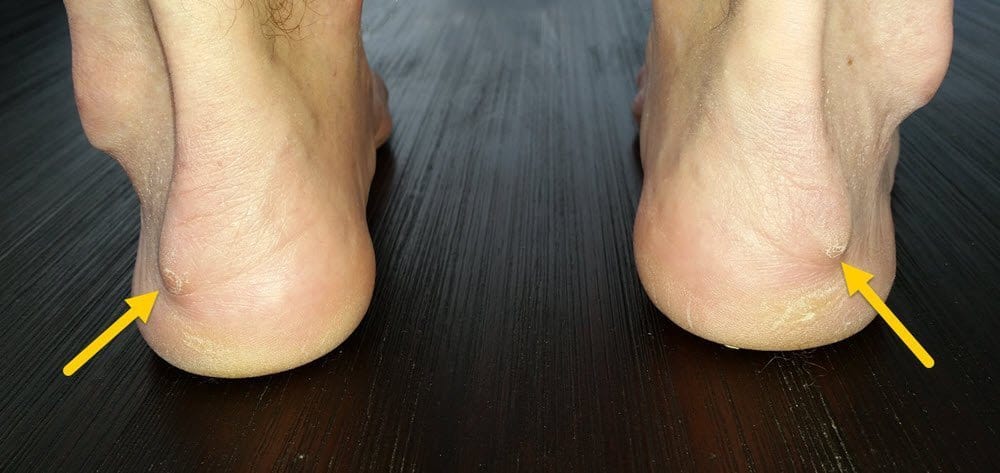
This is a really pointy Haglund's Deformity. Others are not then pinpoint but bigger and bulkier.
Non undoing your laces
If when y'all put your shoes on, you forcefulness your heel over the padded heel counter with excessive force, this can wear away at the lining of the shoe. It will happen higher upwards at the heel neckband rather than the heel counter below. This often happens when you don't undo your laces. Just another reason to undo your laces every time ?
Heel slippage
If your heel rubs up and down at the back of the shoe, the shoe lining will likely wear out sooner than it normally would. That makes sense, doesn't it? But think just a little further. For this to happen, you'd take to have a friction situation where your sock remains in close contact and basically stuck to your skin with high friction levels. Then the abrasiveness of the sock would wear away at the shoe lining. However, as soon equally the friction situation changed and your human foot moved within the sock, your shoe would be saved from that abrasive rubbing. Information technology'southward almost impossible to tell what'southward rubbing against what in a real-life situation, just y'all get my migrate. Heel slippage can be involved, but information technology's not always involved. If yous think it is, utilize the heel lock lacing technique.
Stride length
Information technology's possible that there is more force exerted to the shoe lining at the back of the heel with a longer pace length compared to a shorter stride length. Imagine stepping forward only ever and so slightly – impact volition be mainly felt past the area under the heel. At present imagine taking a big long over-stride. Sure, the lesser of the heel withal bears some force. But at that place'southward a significant amount of force imparted to the heel counter expanse from the dorsum of the heel.
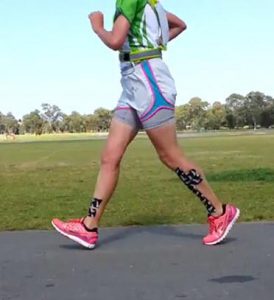
Shoe lining materials
This one has to exist relevant to some degree. Just you lot're non going to be able to tell at the shoe shop if your new shoes are more susceptible to getting holes in them or not. I'1000 non privy to the friction levels or immovability of the dissimilar lining materials used in this part of the shoe and whether there are significant differences between shoes. Nor are the people in your shoe shop, I'm sure. Merely it makes logical sense that this could be involved. In terms of friction, the lining of shoes has to strike a balance between beingness high friction enough to provide traction for the foot inside the shoe, and low friction enough to allow the sock-covered foot to slide in. Separately, I'g sure some materials are harder-wearing than others. I've besides seen some shoes pill desperately at the dorsum of the heel.
Pronation?
I'thou not buying this ane. It's mentioned a lot, so I thought I'd better include it hither. Just I accept not seen a correlation, permit alone exist able to explain it mechanically.
Fixing (and preventing) holes at the back of your shoes
I've seen and tried several things to stop the lining wear through at the back of my shoes for both myself and my patients. Here's what I've found.
Selection i: Heel-grips
These will work, they will save your shoes. Because literally, you'd accept to wearable all the fashion through the heel grip before you got to the shoe. At that signal, you'd put another sacrificial heel grip on. Even so, heel grips won't end you lot from getting blisters. I still get blisters with heel grips, in fact, my blisters are worse. That'due south because the heel grip is made from a high friction material. The inkling is in the name. Grip equals loftier friction level. Information technology's similar to moleskin. Moleskin is made of cotton wool, which nosotros all know attracts h2o and is non a good material to apply in blister prevention because with a little moisture, it leads to higher friction levels.
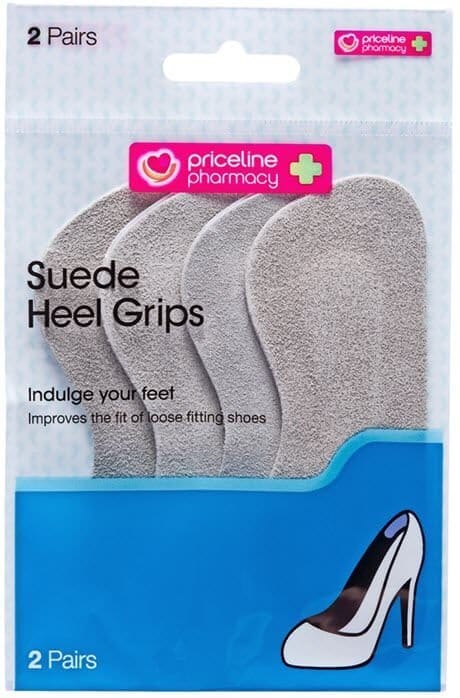
If your only effect is with your shoes and y'all're not getting blisters, use a heel grip. If you need to relieve your shoe AND your skin, it's a footling more complicated.
Pick ii: Denim or leather patch
This one I've personally tried in an attempt to patch the holes in the dorsum of my shoes. I used a soft leather. Denim is also discussed in a couple of blogs here and here. Whatsoever material is used, it is glued and/or sewn in past a bootmaker to cover the clothing area. This volition surely embrace the pigsty and give you more material to wear through before you got to the shoe lining again. Only allow's call back near the materials mentioned here.
Denim is 100% cotton (read this about moleskin) equally are most cloth materials used for this purpose. While it volition give your shoes an extended life, if you're also trying to preclude blisters, this is unlikely to piece of work. Information technology's a similar (slightly different) story for leather. It didn't help my blisters at all, but gave my shoes an extended life. At this point, I just want you to remember moleskin / denim (ie: cotton) and leather for when we accomplish option half-dozen and look at a couple of graphs.
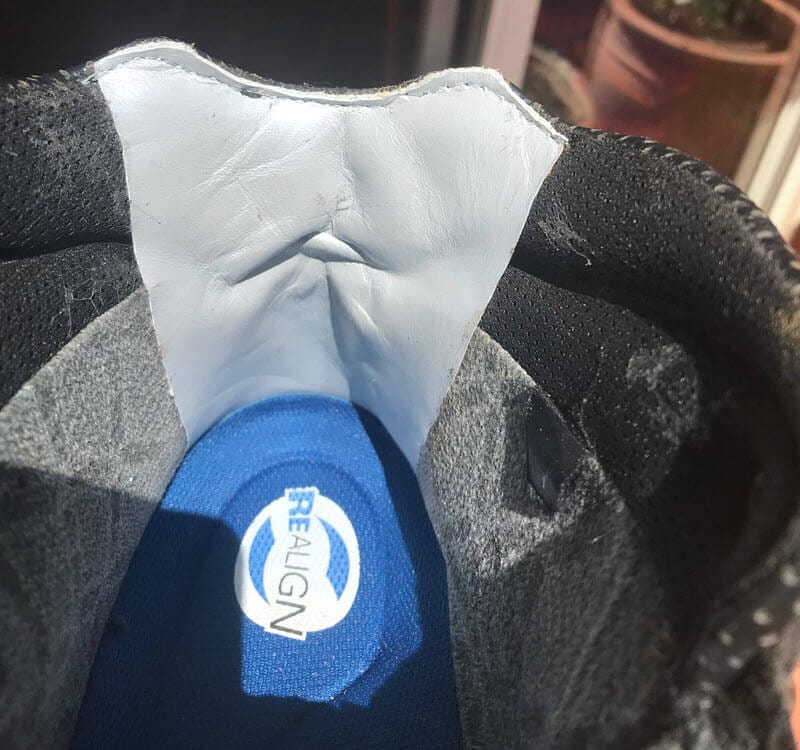
Leather glued and sewn onto the rear interior of a kicking
Option iii: Fabric covered gel sheeting
The gel textile used in gel toe sleeves and caps is great for preventing blisters. It can exist purchased in adhesive sheets with a thickness of 5mm. You can trim a heel-grip shape and apply it to the back of your shoe, but like a heel grip. The cloth itself undergoes a lot of shear (internal stretching) via its low shear modulus. This means the skin is spared of some shear that could lead to blisters. I've used this myself to stop wearing holes in my shoes, and with a few patients. The difficulty with it is that it rolls down. Due to the thickness of the material, your sock catches the summit of the material likewise easily when you slide your heel into your shoe and the gel ends up rolling downward. Information technology tin can also habiliment out quickly in the presence of a Haglund's deformity. It's unfortunate because on the face of information technology, this material holds a lot of promise. However, fear not, because meliorate options and the articulate winner is coming up.
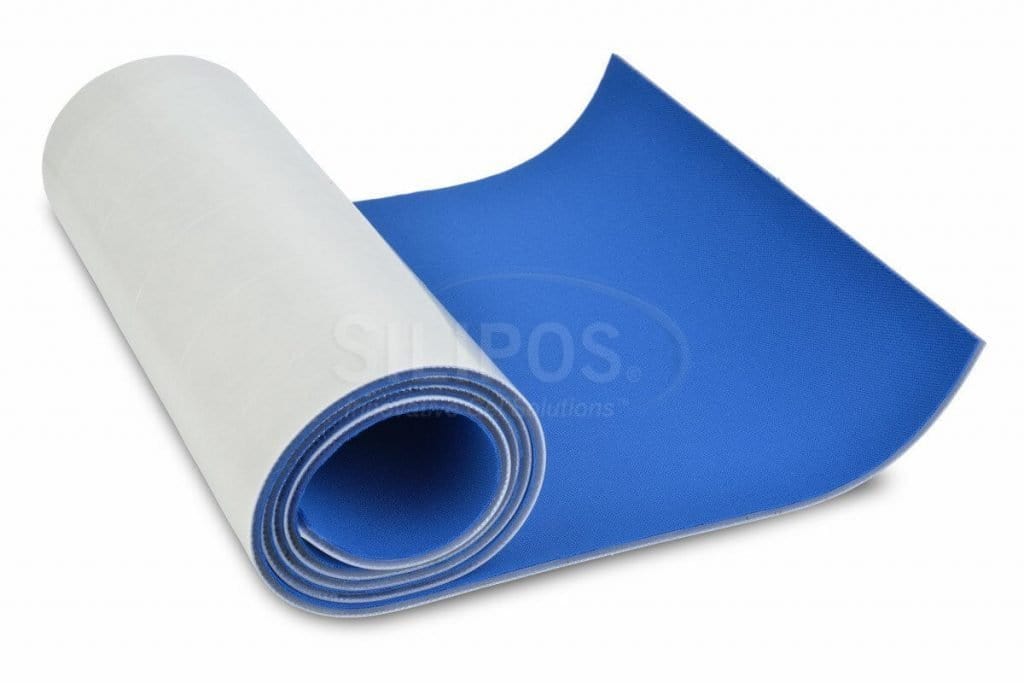
Silipos gel sheeting – can be cut to whatever shape
Option 4: Duct record
Forget newspaper tape, Fixomul or Elastoplast. Duct tape is by far the best tape to use to comprehend any holes. It presumably has lower frictional properties compared to other tapes (though I tin can't for the life of me find whatsoever Coefficient of Friction stats) and is hard-wearing, no doubt. But you've got to avoid folds and creases like the images below. These areas of loftier focal pressure will irritate the skin. Easier said than washed, I know.
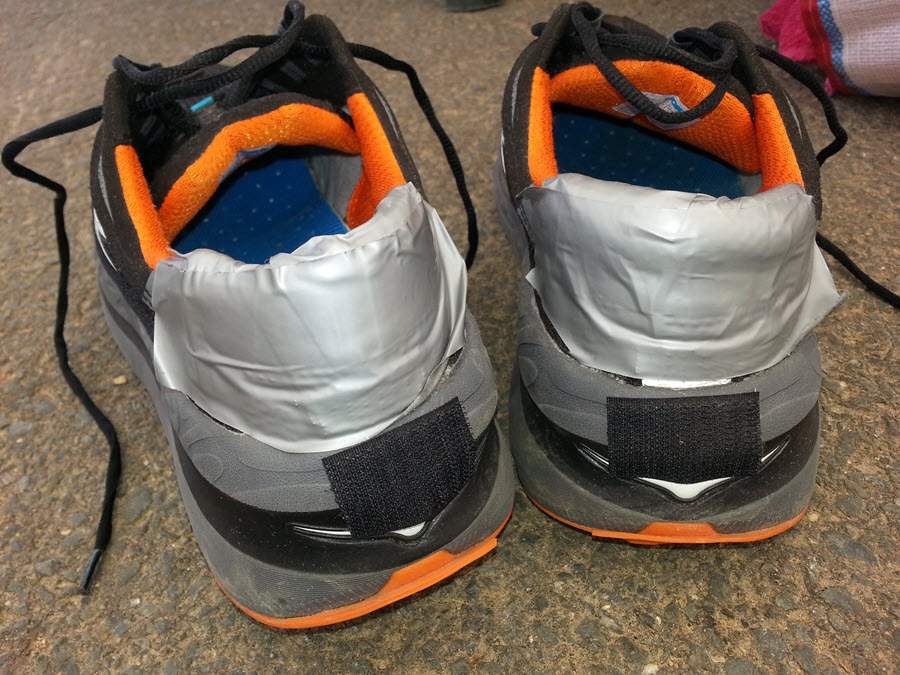
Duct tape to fight holes in the dorsum of running shoes
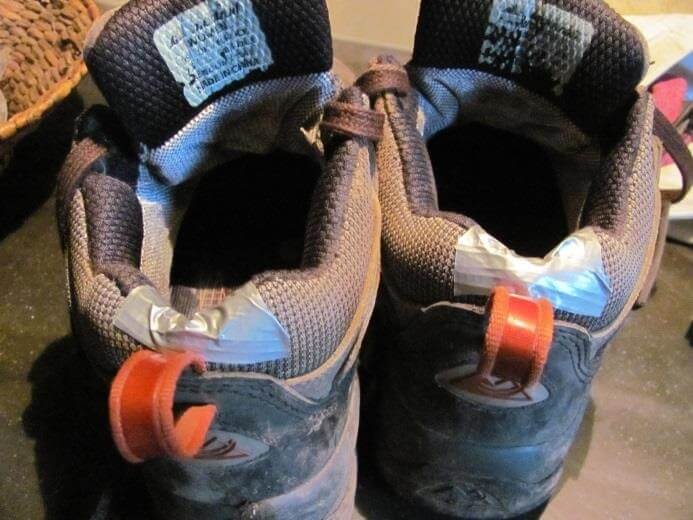
Using duct record at the back of the shoe/boot – avoid creases and folds to preclude skin trauma
Selection 6: ENGO Blister Patches
ENGO Blister Patches are blue agglutinative stickers, purpose-fabricated for sticking to the shoe lining to forestall blisters. They are a brilliant class of cicatrice prevention, cheers to the very low friction fabric that coats them. It'south called PTFE and information technology's known to have a very low friction level. Teflon is fabricated from the same PTFE material. ENGO Patches have a COF nether 0.2 in both dry out and clammy conditions. Take a look at the graphs beneath. Note the friction levels for moleskin and leather.
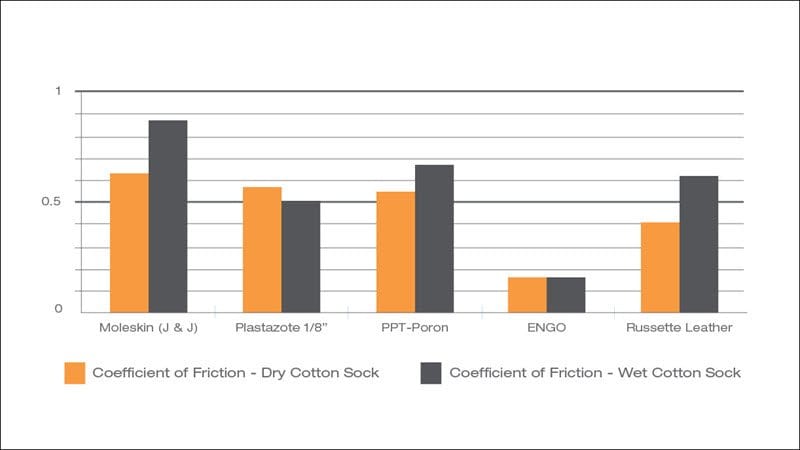
ENGO'southward coefficient of friction remains low in the presence of wet – Carlson (2001)
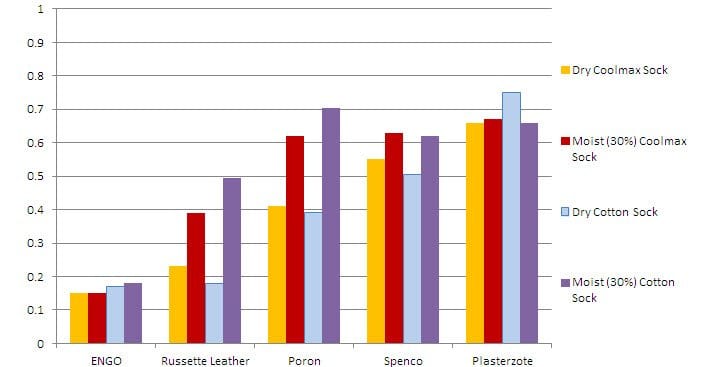
Coefficient of friction data in dry and moist conditions – Payette (2010)
You apply ENGO Patches to your shoe just similar a heel-grip. They're much thinner than a heel grip and and so this makes information technology easier to avoid catching the superlative of the patch as your slide your heel into your shoe. However, some care is yet needed. Read this how-to for applying ENGO Patches to your footwear. They prevent wearing at the back of your shoe spectacularly! They are surprisingly hardy, lasting months and months at a time (or over a yr in my example). You lot can also use them to fix existing holes, similar I did here on my father-in-law's shoes (below). I just pushed all the cream back into place, folded the edges of the worn lining back down as all-time I could, and popped an ENGO Patch over it to cover it all upward. I used a large oval here from the ENGO 4-Pack, but y'all can also employ the heel patches of course.
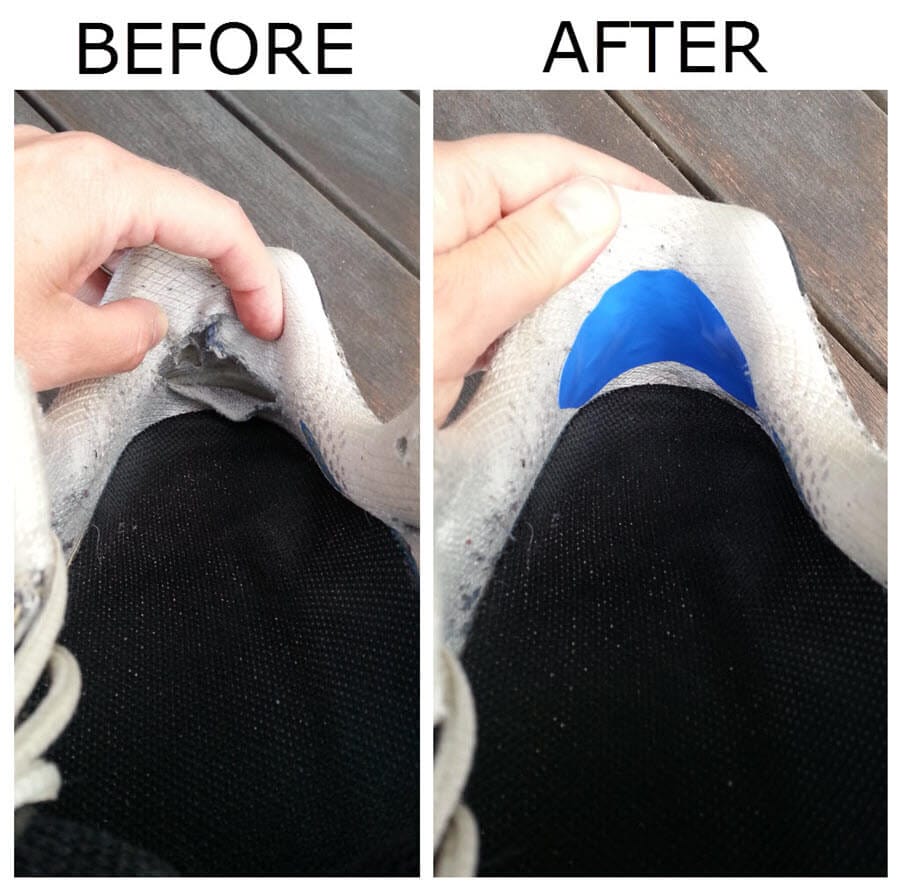
Using an Engo patch to encompass a wear hole at the dorsum of the shoe
How To Get Started With ENGO Heel Patches
References
- Carlson JM. 2001. The friction factor. OrthoKinetic Review. one.7 Nov-December: 1-3.
- Payette Grand. 2010. Friction management for diabetic foot bug. Presented at the 36th Annual Meeting and Scientific Symposium of the American Academy of Orthotists and Prosthetists.
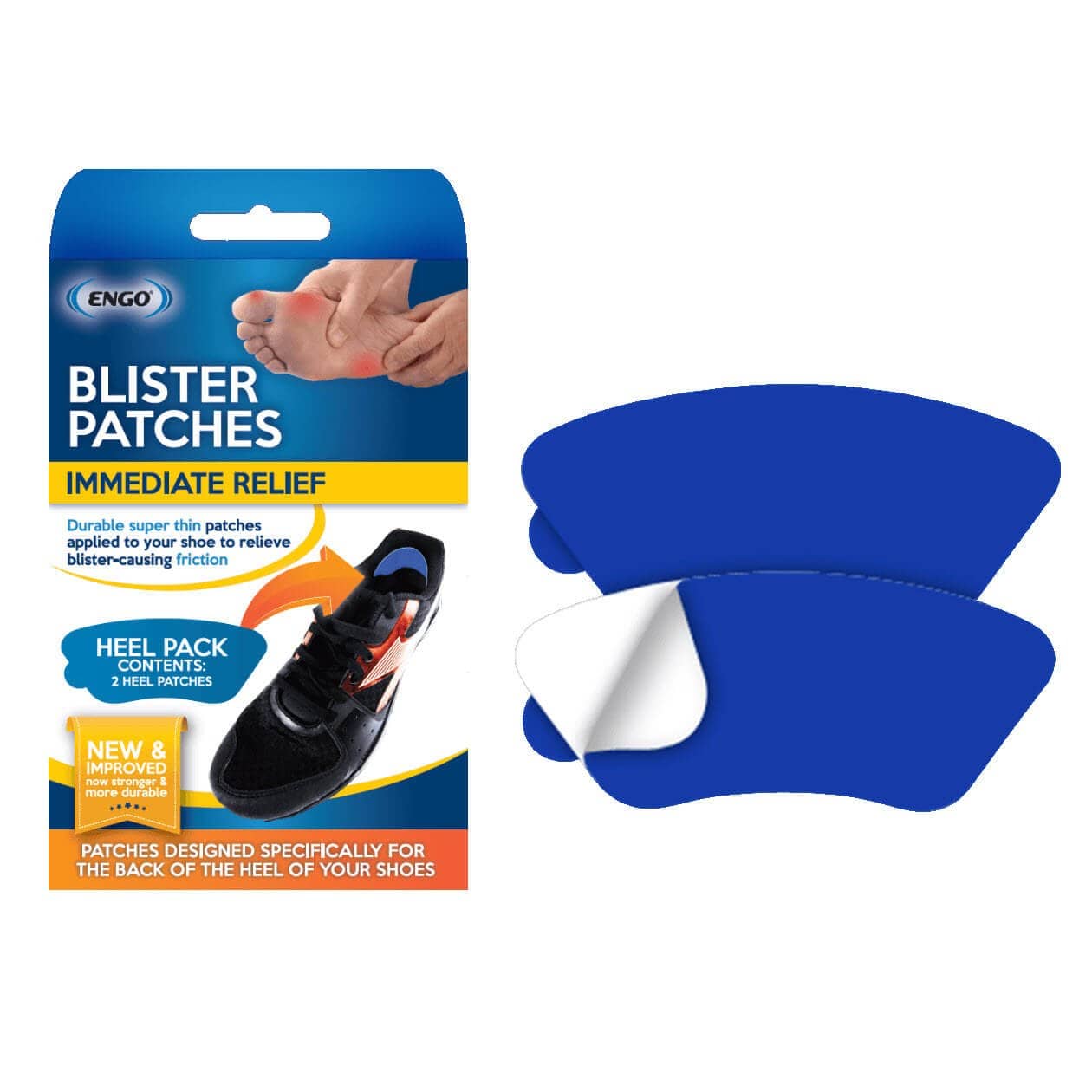
ENGO Blister Patches Heel Pack
The ENGO Blister Patches Heel Pack is specially designed for full coverage of dorsum of heel blisters and to fix wearing holes in the dorsum of the shoe.
VIEW PRODUCT
About The Author
Podiatrist, blister prone ex-hockey player, human foot blister thought-leader, author and educator. Can't cook. Loves exam cricket.

ENGO Blister Patches Heel Pack
The ENGO Cicatrice Patches Heel Pack is specially designed for total coverage of back of heel blisters and to ready wearing holes in the back of the shoe.
VIEW Production
Related Posts
10 Comments
What Can I Use To Repair The Back Heel Of Shoes,
Source: https://www.blister-prevention.com/holes-in-the-back-of-my-shoes/
Posted by: morgantabstair.blogspot.com

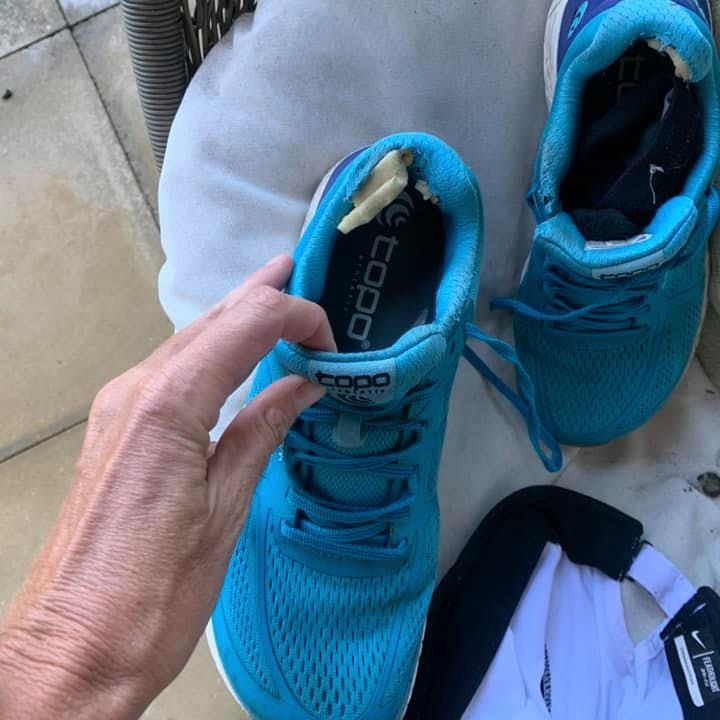

Thanks for the article Rebecca. It'south logical and, almost importantly, information technology includes numerous practical solutions. Thumbs up.
Thanks for the thorough item of the reason i accept destroyed v pairs of preparation shoes this year alone uppers are near new only holes on the inside of my left heel
Thanks for the article. What blazon of guy would yous recommend for the leather glued/sewn pick?
Do you mean gum Allison? Shoe Goo would exist a good choice. Or a bootmaker will exercise information technology all for yous.
i have been wearing 2 pair of socks with padding which works pretty practiced for a while. once the hole wears in the heal of the shoe, I have a paper towel and fold it, then stick it into the heal of my shoe and slide my shoe on carefully, this works really well. As the paper towel wears and thins, I replace information technology with another. Cheap and works well. I always thought I was one of but a few with this problem, until I googled and got this forum.
I have a very similar problem with work boots, NOT the blisters, simply the wearing down internally of the back of the work boots, backside my heel, merely likle in the images!! Tried 3 dissimilar pairs of piece of work boots, and even the more expensive ones seem to wearable away too. No sign of hard spots on my anxiety, an I am certain I am buying the correct sizes…..Will the a few of these options, but the cause is still a mystery, I do article of clothing the boots for an extended period of time, so maybe the sweat and moisture/heat is all contributing too ???
The problem is the friction level between the shoe and the sock. You lot could play effectually with different socks, but essentially frictional properties of shoe lining materials and socks are not available, and so we're all only guessing.
Having very loftier arches, when I started long distance walking 3 years ago, I went through 2 pairs of expensive shoes before putting duct tape in the heals. I waffled about this because, they were brand new shoes, I don't want to muck them upward with some sticky one-time cheap duct tape! Merely now that I HAVE put it in my brand new shoes, I Couldn't be happier with the result. Duct tape. Cheap durable, and lets my heal slide without forming blisters. I found the fox is to split the tape at the top of the heal and drapery it over the back of the shoe. There is commonly a pull tab you take to work effectually anyway so the split lets yous practise that, and it is easier to continue wrinkles and folds of the record from happening. It's not pretty, just hey, pretty, is not the signal, protection is.